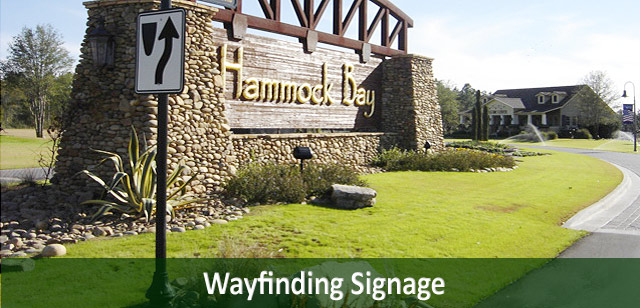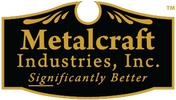Wayfinding Signage Information

All transportation and redevelopment projects, as well as new community developments, require some signage. It’s a matter of whether that signage will be the minimum required – an afterthought, or will be comprehensively planned to compliment the rest of the project and the project’s marketing and livability goals.
If you look around critically, you will notice that much existing signage in existing districts and neighborhoods is incomplete, and poorly maintained – as well as having inappropriate and unauthorized additions.
Tourism and retail sales of goods and services are significant elements of the economy of downtown districts and of our communities. Encouraging, easing, and enhancing the visitor experience can be a very productive investment and clearly a part of creating a sense of place.
Like the other parts of new developments and redevelopment projects, park enhancements, road improvements, and parking facilities, a comprehensive wayfinding program combined with road clutter reduction, can enhance the experience of the community and its sense of place for residents and visitors alike. It can increase tourism and enhance retail revenues – contributing to economic vitality, quality of life, and community pride. Improved circulation and shortened searches for destinations and parking can reduce accidents, trip lengths, fuel consumption, and pollution.
As with other capital improvements, wayfinding systems can be designed to reinforce the “brand” of the community or district. In addition, the walking and biking experiences can be encouraged, enhanced, and lengthened.
An article in American City and County Magazine in March 2003 stated:
| “In the end, wayfinding is as much about the success and identity of the city as it is about clearly presenting information and promoting safety. By using a common look and consistent design that speaks in a consistent voice, wayfinding instills user confidence, reflects a more secure environment and creates a unique sense of place.” |
Sign Standards
The national standard for road signs, the Manual on Uniform Traffic Control Devices (MUTCD) states:
| “The purpose of traffic control devices, as well as the principles for their use, is to promote highway safety and efficiency by providing for the orderly movement of all road users on streets and highways…Traffic control devices notify road users of regulations and provide warning and guidance needed for the reasonably safe, uniform, and efficient operation of …traffic...” |
Standard road sign systems often are not detailed and comprehensive enough to support community goals and their nationally standardized designs don’t enhance local brand identity.
Changes to the MUTC, adding a section, 2D.52, “Community Wayfinding Signs” state:
- Community wayfinding guide signs direct tourists and other road users to key civic, cultural, visitor, and recreational attractions and other destinations within a city or a local urbanized or downtown area.
- Color coding is sometimes used on community wayfinding signs to help road users distinguish between multiple potentially confusing traffic generator destinations within a community or area.
- Community wayfinding guide signs are a type of destination guide sign for conventional roads with a common color and/or enhancement marker identifier for destinations within an overall wayfinding guide sign plan for an area.
- Community wayfinding guide signs may include panels that have background colors other than green in order to provide a color “identity” for the wayfinding destinations by type or group of destinations or by geographical area within the overall wayfinding guide signing system.
- Pictographs that comply with the size and design provisions of Section 2D.07 may be used on community wayfinding guide signs.
- Other graphics that specifically identify the wayfinding system, including enhancement markers, may be used on the overall signing assembly and sign posts.
The Florida DOT Traffic Engineering Manual states:
| “The Department, in cooperation with the Florida League of Cities, has developed statewide criteria for Wayfinding Signs on our State Highway System. These standards provide local governments the flexibility to design their own Wayfinding Sign System while still maintaining federal and state sign standards to safely guide motorists to their destinations.” |
Similar statutes are common in all 50 states.
Private Developments
Florida Statute 316.0747 states:
(1) It is unlawful for any nongovernmental entity to use any traffic control device at any place where the general public is invited, unless such device conforms to the uniform system of traffic control devices adopted by the Department of Transportation pursuant to this chapter.
(2) Nongovernmental entities to which the general public is invited to travel shall install and maintain uniform traffic control devices at appropriate locations pursuant to the standards set forth by the Manual on Uniform Traffic Control Devices as adopted by the Department of Transportation…
(3) A person who violates this section commits a misdemeanor of the second degree, punishable as provided.
Wayfinding Web
Wayfinding planning involves implementation that resembles a spider web with concentric circles and radial and connecting lines. Travelers approach the circles - community, community center, districts, and destinations; they travel along major thoroughfares, onto local streets, and into parking facilities. Whenever line meets a circle or intersects with another line, there is an arrival or decision point – often requiring signage.
A wayfinding plan researches and analyzes boundaries, routes, decision points, and destinations, as well as signs and sign content required.
Sign Types
- Gateway, boundary, and locator
- Guide, trail blazer, and directional
- Directory, interpretive mapping, and informational
- Regulatory, warning, and street name
- Banners and Transit
Sign Elements
- Post/Pole – single or multiple, usually round, might be square or other shape, such as smooth or fluted; possibly frangible as a crash breakaway feature.
- Pole BASE – decorative element that might match or compliment street light poles or other street furniture, such as benches or litter receptacles.
- Sign Panel – box frame, panel, or built-up, contains sign legend, graphic, and/or pictograph
- Finial – decorative top cap of the post/pole or accessory rods
- Fittings – connections and fastenings
Considerations when choosing materials
- Family of Signs General Specifications
- Sign Unit Design Details
- Structure Types and Specifications
- Sign Type Use Within Program
- Pricing Alternatives
- Permitting Requirements (State,County,City)
- Installation Requirements
- Maintenance, replacement, expansion
Planning a Wayfinding System
- Research customer goals
- Study boundaries, jurisdictions, routes, decision points, destinations, and existing signage
- Develop database and mapping for sign locations, sign legends, sign and legend sizes
- Design, engineer, develop specifications for signs and other street furniture
- Prioritize and budget
